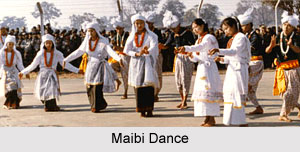 Folk dances of Manipur hold a distinct place in the cultural arena of the country. Manipuri dances, whether the classical ones or the folk dances, are all devotional in nature. These were originally only performed in temples and it yet continues to form an integral part of the religious and social fabric of Manipur. The people of Manipur are very religious and are exclusively attached to the Hindu deities Radha and Krishna, who are often the main characters depicted in Manipuri folk dances.
Folk dances of Manipur hold a distinct place in the cultural arena of the country. Manipuri dances, whether the classical ones or the folk dances, are all devotional in nature. These were originally only performed in temples and it yet continues to form an integral part of the religious and social fabric of Manipur. The people of Manipur are very religious and are exclusively attached to the Hindu deities Radha and Krishna, who are often the main characters depicted in Manipuri folk dances.
Pung Cholom Dance of Manipur
Pung Cholom is folk art form with a combination of sound and movements, which sometimes demand acrobatic abilities and stamina. The dancers themselves play the Mridanga (Pung) while executing the performance in front of the audience.
Maibi Dance
Maibi dance is performed during the celebration of festival Lai Haraoba, which is an annual ritual festival of the Meitei Manipuris, living in the valley of Manipur. Lai Haraoba refers to frolic of the gods. The principal performers are the Maibis and Maibas, who are specially selected men and women, chosen by the gods to honour them, since they are considered an embodiment of purity. It is essentially a ritualistic dance and considered the precursor of Manipuri as seen today. The Lai Haraoba is still an important living tradition. To unfold the story of creation, the dancers make use of certain stylized hand gestures and body movements, but the face remains blank.
 Khamba Thaibi
Khamba Thaibi
Khamba Thaibi dance is a popular art form, widely performed in Manipur. Generally, it is performed either as part of Lai Haoraoba or as an independent performance. For performing this dance, the men performers pick up their partners at dance arena, where the girls are decked up with colourful dresses along with the flowers in their hands. This dance is a duet performance describing the story of a poor and brave lad of the Khuman clan of Khamba, who fell in love with Thaibi, a princess of Moirang. Thus, by this dance, the partners show a dedication to the sylvan deity known as Thangjing of Moirang.
Nupa Dance of Manipur
Nupa dance or Nupa Pala is also known as Kartal Cholom or Cymbal dance, performed in a group, only by the men folk. This dance represents the unique Manipuri style of dance and music, where the performers sing and dance to the rhythm of the Pung. The movements involved in this dance are soft, gentle and serene during the initial stage; however, it gradually gathers momentum in it. Generally, the Nupa dance acts as a prologue or an introductory dance to the Raslila dances; however, it can also be performed in connection with religious rites. The men wear white Pheijom (Dhoti) and snow-white ball-shaped large turbans on their head while performing this dance.
Raslila Dance of Manipur
Raslila is another folk dance of Manipur which is capable of evoking profound emotions in people. Eternal love of Radha and Krishna is depicted through these dances, as narrated in Hindu scriptures and Puranas. In true sense, Raslila is the illustration of association of an individual soul with the spirit of Supreme Being. The steps and dancing styles differs while the central theme remains the same. It is said that there are five categories of Raslila which include Maha Rasa, Kunja Rasa, Basanta Rasa, Diva Rasa and Nitya Rasa.



















